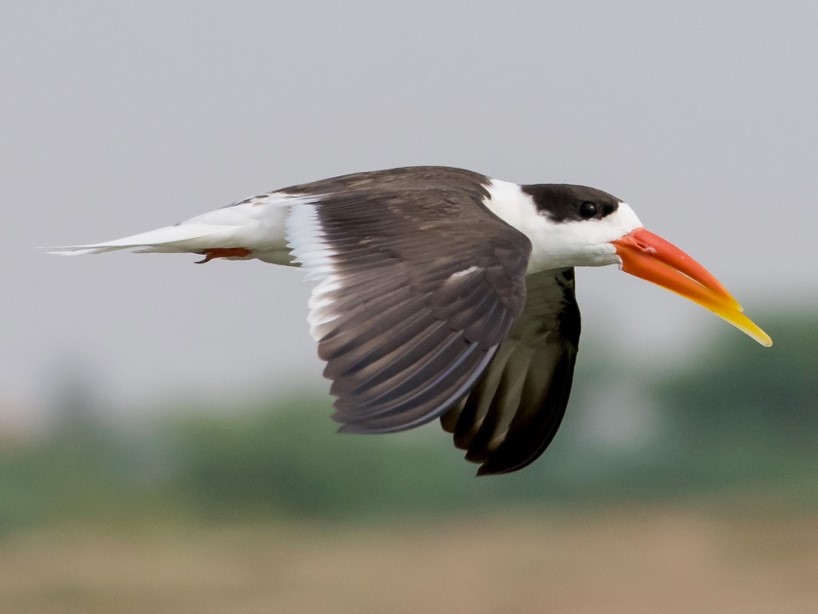Description

Disclaimer: Copyright infringement not intended.
Context
- At Satkosia wildlife sanctuary, breeding of Indian Skimmers has been recorded for the first time.
Details
- The sanctuary managers recently found that breeding of the Skimmer species, one of the three found across the globe, has taken place at Baladamara sandbar in the 22-km Satkosia gorge stretch of Mahanadi river.
- The Indian Skimmers usually arrive at Satkosia in November and leave by March second week.
- The Indian Skimmer is native to India, Bangladesh, Myanmar, Nepal, Pakistan and Vietnam. Their last breeding in the Mahanadi river stretch was recorded years back in Munduli area.
- Since there are anthropogenic activities in other areas, the Skimmers are in search of new breeding grounds. Satkosia gorge is free from any kind of biotic interference which is why nesting took place here this year.

About Indian Skimmer
|
FACTS
Scientific Name: Rynchops albicollis
Common Names: Indian skimmer, Indian scissors bill
Taxonomy:
Kingdom: Animalia
Phylum: Chordata
Class: Aves
Order : Charadriiformes
Family: Laridae
Genus: Rynchops
Species: albicollis
Conservation Status:
IUCN: Endangered
CITES: Not listed
IW(P)A: Not listed
|
Distribution
- More widespread in winter, the Indian skimmer is found in the coastal estuaries of western and eastern India.
- It occurs primarily on larger, sandy, lowland rivers, around lakes and adjacent marshes and, in the non-breeding season, in estuaries and coasts.
Characteristics, Habitat and Behaviour
- The Indian skimmer grows to a length of 40-43 cm.
- It breeds colonially on large, exposed sand-bars and islands.
- It emits a nasal kap or kip notes, particularly in flight and when disturbed.
Major Threats
- Habitat degradation: Exploitation and degradation of rivers and lakes through fishing, transportation, domestic use, irrigation schemes and pollution from agricultural and industrial chemicals are largely responsible for the decline of this species as these factors have reduced reproductive and foraging success.
- Excessive and widespread increases in disturbance:
- The damming of the Chambal River, in upstream Rajasthan, has adversely affected its population at National Chambal Sanctuary, Uttar Pradesh, due to the dropping water levels allowing predators and livestock access to breeding islands.
- Predation by corvids like House crows (Corvus splendens), presence of stray and domestic dogs, have been known to decimate breeding colonies.

About the Satkosia Tiger Reserve
- Satkosia Tiger Reserve is a tiger reserve located in the border of Angul and Nayagarh district of Odisha, India covering an area of 988.30 km².
History
- Satkosia Gorge Wildlife Sanctuary was created in 1976, with an area of 796 km².
- Satkosia Tiger Reserve was designated in 2007, and comprises the Satkosia Gorge Wildlife Sanctuary and the adjacent Baisipalli Wildlife Sanctuary.
Terrain
- It is located where the Mahanadi River passes through a 22 km long gorge in the Eastern Ghats mountains.
Flora
- The major plant communities are mixed deciduous forests including Sal (Shorea robusta), and riverine forest.
Fauna
- Mammals found include the leopard, indian wild dog or the (dhole), wild boars , striped hyena, sloth bear, leopard cat and the jungle cat.
- The major herbivores include the Asian elephant which is found in large numbers and can often be seen crossing rivers.
- The reptiles here include the Mugger Crocodile and gharials
- This place also has many fishes like the cat fish which can have a weight of about 30 kilograms.
- The National Tiger Conservation Authority, which had approved the transfer of six tigers from the wild of Madhya Pradesh's Kanha National Park to Satkosia Tiger Reserve in Odisha, has suspended the tiger translocation project pending a detailed review.
|
PRACTICE QUESTION
Q) Which of the following statements with reference to Indian Skimmer is/are incorrect?
a. Indian skimmer is found in the coastal estuaries of eastern India only.
b. The Indian Skimmer is native to India, Bangladesh, Myanmar, Nepal, Pakistan and Vietnam.
- a only
- b only
- both a and b
- neither a nor b
Correct Answer: 1
|

https://www.newindianexpress.com/states/odisha/2023/apr/19/indian-skimmers-breed-at-satkosia-wildlife-sanctuary-2567390.html












